China's Economic Development: Savings, GDP, and Policy Recommendations
VerifiedAdded on 2022/10/19
|7
|2399
|3
Essay
AI Summary
This essay provides a detailed analysis of China's economic evolution over the past 15 years, examining key indicators such as savings rates, Gross Domestic Product (GDP), and GDP per capita. The analysis explores the impact of the one-child policy, pension reforms, and income uncertainty on savings rates, highlighting their influence on economic growth. The essay also investigates the contribution of investment, government expenditure, and net exports to GDP growth, emphasizing the role of foreign direct investment, government spending on Research and Development (R&D), and net exports. Furthermore, the essay delves into the factors affecting GDP per capita, including labor productivity and the size of the employed population, considering the effects of human capital accumulation, labor mobility, and entrepreneurship. The essay concludes with policy recommendations to boost the Chinese economy, focusing on increasing government spending on healthcare, education and R&D, and creating more opportunities for entrepreneurship.
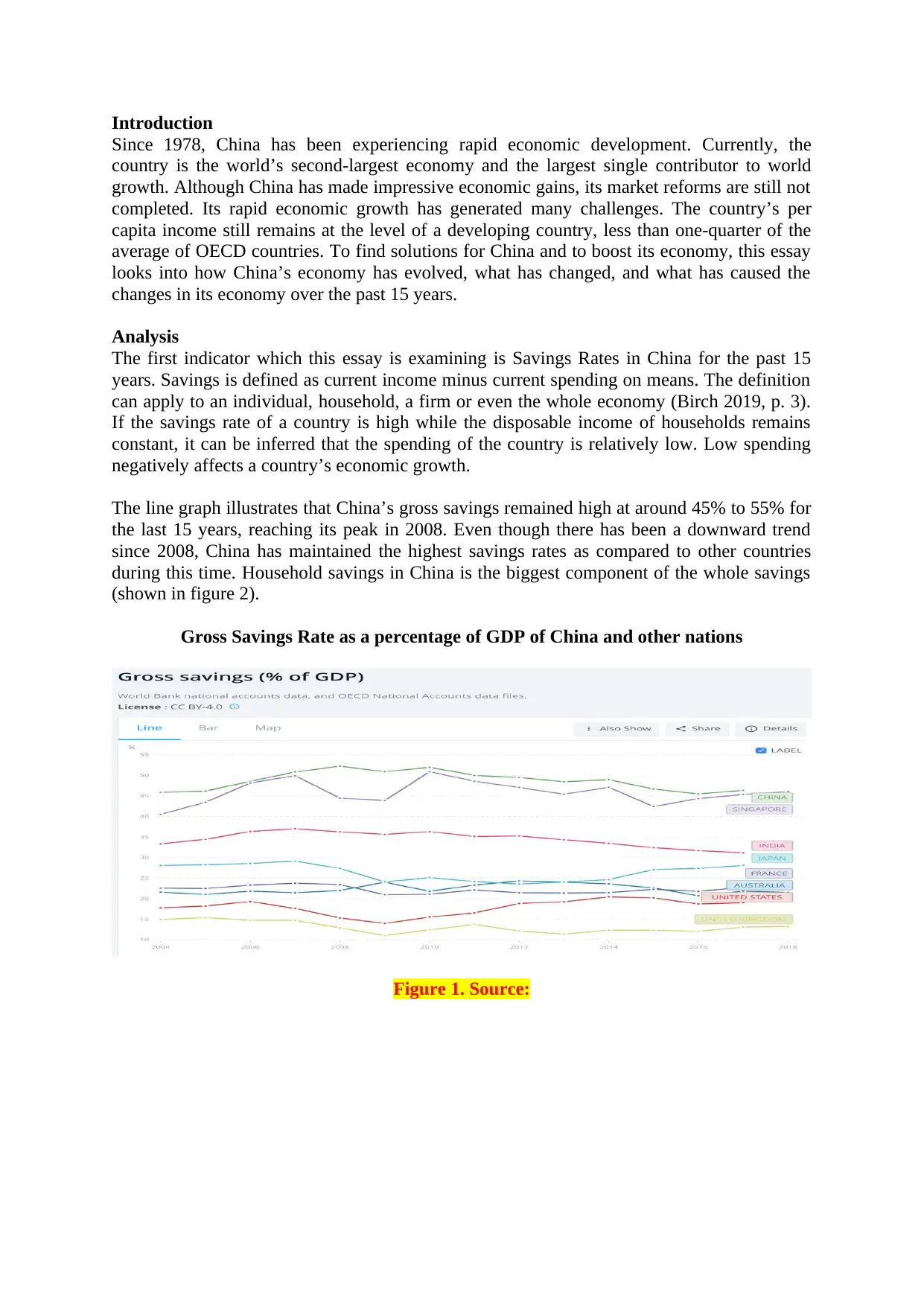
Introduction
Since 1978, China has been experiencing rapid economic development. Currently, the
country is the world’s second-largest economy and the largest single contributor to world
growth. Although China has made impressive economic gains, its market reforms are still not
completed. Its rapid economic growth has generated many challenges. The country’s per
capita income still remains at the level of a developing country, less than one-quarter of the
average of OECD countries. To find solutions for China and to boost its economy, this essay
looks into how China’s economy has evolved, what has changed, and what has caused the
changes in its economy over the past 15 years.
Analysis
The first indicator which this essay is examining is Savings Rates in China for the past 15
years. Savings is defined as current income minus current spending on means. The definition
can apply to an individual, household, a firm or even the whole economy (Birch 2019, p. 3).
If the savings rate of a country is high while the disposable income of households remains
constant, it can be inferred that the spending of the country is relatively low. Low spending
negatively affects a country’s economic growth.
The line graph illustrates that China’s gross savings remained high at around 45% to 55% for
the last 15 years, reaching its peak in 2008. Even though there has been a downward trend
since 2008, China has maintained the highest savings rates as compared to other countries
during this time. Household savings in China is the biggest component of the whole savings
(shown in figure 2).
Gross Savings Rate as a percentage of GDP of China and other nations
Figure 1. Source:
Since 1978, China has been experiencing rapid economic development. Currently, the
country is the world’s second-largest economy and the largest single contributor to world
growth. Although China has made impressive economic gains, its market reforms are still not
completed. Its rapid economic growth has generated many challenges. The country’s per
capita income still remains at the level of a developing country, less than one-quarter of the
average of OECD countries. To find solutions for China and to boost its economy, this essay
looks into how China’s economy has evolved, what has changed, and what has caused the
changes in its economy over the past 15 years.
Analysis
The first indicator which this essay is examining is Savings Rates in China for the past 15
years. Savings is defined as current income minus current spending on means. The definition
can apply to an individual, household, a firm or even the whole economy (Birch 2019, p. 3).
If the savings rate of a country is high while the disposable income of households remains
constant, it can be inferred that the spending of the country is relatively low. Low spending
negatively affects a country’s economic growth.
The line graph illustrates that China’s gross savings remained high at around 45% to 55% for
the last 15 years, reaching its peak in 2008. Even though there has been a downward trend
since 2008, China has maintained the highest savings rates as compared to other countries
during this time. Household savings in China is the biggest component of the whole savings
(shown in figure 2).
Gross Savings Rate as a percentage of GDP of China and other nations
Figure 1. Source:
Paraphrase This Document
Need a fresh take? Get an instant paraphrase of this document with our AI Paraphraser
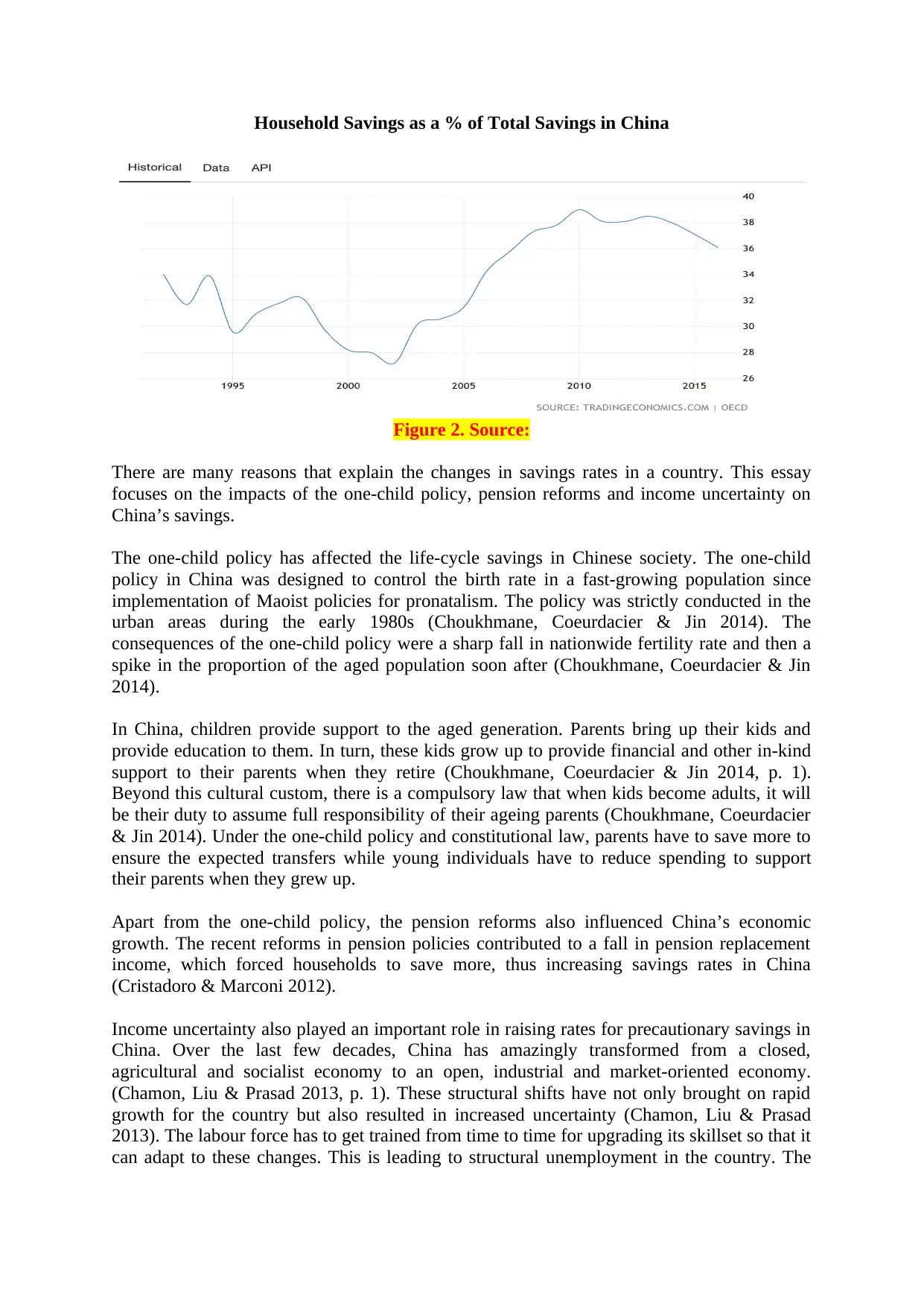
Household Savings as a % of Total Savings in China
Figure 2. Source:
There are many reasons that explain the changes in savings rates in a country. This essay
focuses on the impacts of the one-child policy, pension reforms and income uncertainty on
China’s savings.
The one-child policy has affected the life-cycle savings in Chinese society. The one-child
policy in China was designed to control the birth rate in a fast-growing population since
implementation of Maoist policies for pronatalism. The policy was strictly conducted in the
urban areas during the early 1980s (Choukhmane, Coeurdacier & Jin 2014). The
consequences of the one-child policy were a sharp fall in nationwide fertility rate and then a
spike in the proportion of the aged population soon after (Choukhmane, Coeurdacier & Jin
2014).
In China, children provide support to the aged generation. Parents bring up their kids and
provide education to them. In turn, these kids grow up to provide financial and other in-kind
support to their parents when they retire (Choukhmane, Coeurdacier & Jin 2014, p. 1).
Beyond this cultural custom, there is a compulsory law that when kids become adults, it will
be their duty to assume full responsibility of their ageing parents (Choukhmane, Coeurdacier
& Jin 2014). Under the one-child policy and constitutional law, parents have to save more to
ensure the expected transfers while young individuals have to reduce spending to support
their parents when they grew up.
Apart from the one-child policy, the pension reforms also influenced China’s economic
growth. The recent reforms in pension policies contributed to a fall in pension replacement
income, which forced households to save more, thus increasing savings rates in China
(Cristadoro & Marconi 2012).
Income uncertainty also played an important role in raising rates for precautionary savings in
China. Over the last few decades, China has amazingly transformed from a closed,
agricultural and socialist economy to an open, industrial and market-oriented economy.
(Chamon, Liu & Prasad 2013, p. 1). These structural shifts have not only brought on rapid
growth for the country but also resulted in increased uncertainty (Chamon, Liu & Prasad
2013). The labour force has to get trained from time to time for upgrading its skillset so that it
can adapt to these changes. This is leading to structural unemployment in the country. The
Figure 2. Source:
There are many reasons that explain the changes in savings rates in a country. This essay
focuses on the impacts of the one-child policy, pension reforms and income uncertainty on
China’s savings.
The one-child policy has affected the life-cycle savings in Chinese society. The one-child
policy in China was designed to control the birth rate in a fast-growing population since
implementation of Maoist policies for pronatalism. The policy was strictly conducted in the
urban areas during the early 1980s (Choukhmane, Coeurdacier & Jin 2014). The
consequences of the one-child policy were a sharp fall in nationwide fertility rate and then a
spike in the proportion of the aged population soon after (Choukhmane, Coeurdacier & Jin
2014).
In China, children provide support to the aged generation. Parents bring up their kids and
provide education to them. In turn, these kids grow up to provide financial and other in-kind
support to their parents when they retire (Choukhmane, Coeurdacier & Jin 2014, p. 1).
Beyond this cultural custom, there is a compulsory law that when kids become adults, it will
be their duty to assume full responsibility of their ageing parents (Choukhmane, Coeurdacier
& Jin 2014). Under the one-child policy and constitutional law, parents have to save more to
ensure the expected transfers while young individuals have to reduce spending to support
their parents when they grew up.
Apart from the one-child policy, the pension reforms also influenced China’s economic
growth. The recent reforms in pension policies contributed to a fall in pension replacement
income, which forced households to save more, thus increasing savings rates in China
(Cristadoro & Marconi 2012).
Income uncertainty also played an important role in raising rates for precautionary savings in
China. Over the last few decades, China has amazingly transformed from a closed,
agricultural and socialist economy to an open, industrial and market-oriented economy.
(Chamon, Liu & Prasad 2013, p. 1). These structural shifts have not only brought on rapid
growth for the country but also resulted in increased uncertainty (Chamon, Liu & Prasad
2013). The labour force has to get trained from time to time for upgrading its skillset so that it
can adapt to these changes. This is leading to structural unemployment in the country. The
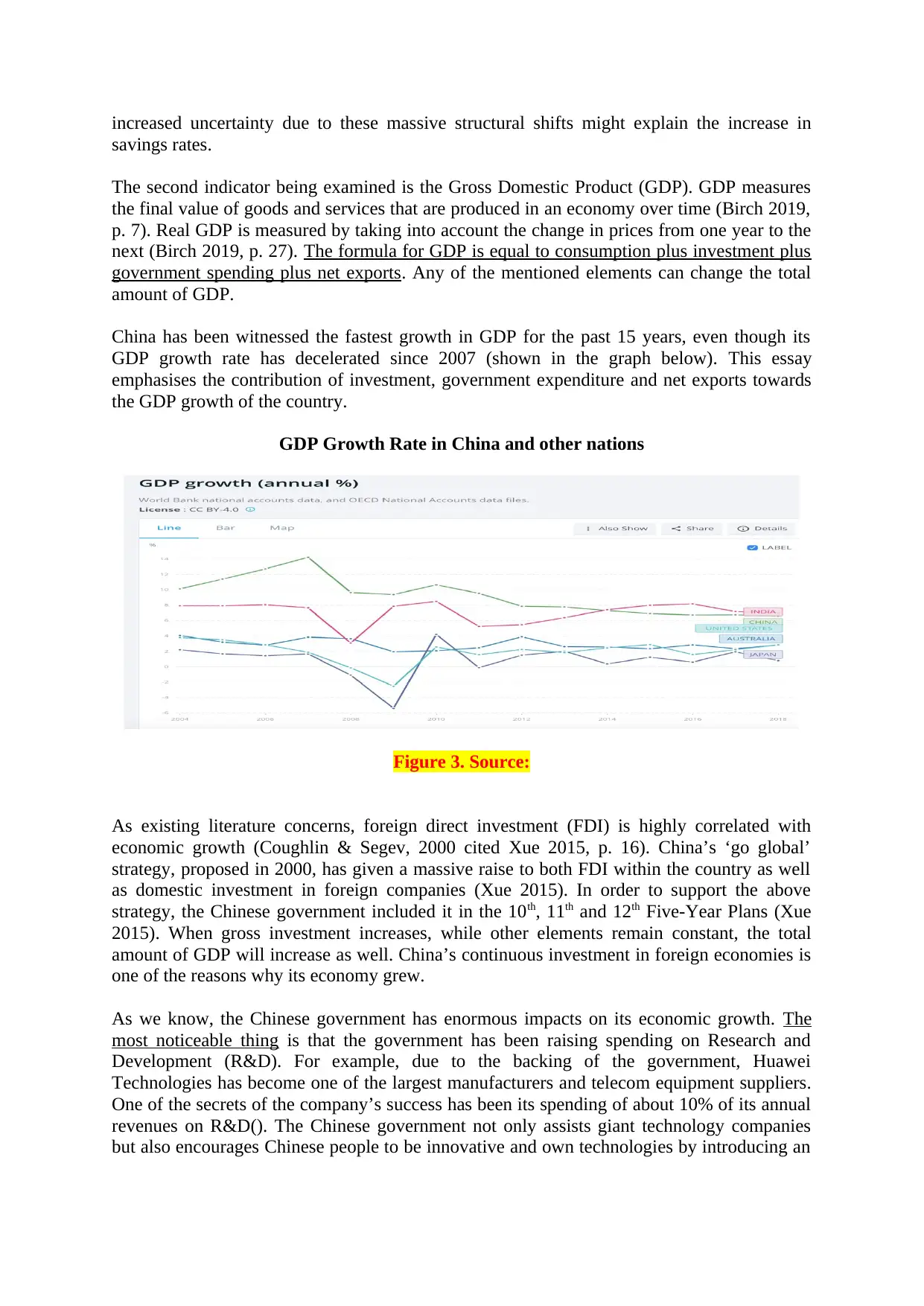
increased uncertainty due to these massive structural shifts might explain the increase in
savings rates.
The second indicator being examined is the Gross Domestic Product (GDP). GDP measures
the final value of goods and services that are produced in an economy over time (Birch 2019,
p. 7). Real GDP is measured by taking into account the change in prices from one year to the
next (Birch 2019, p. 27). The formula for GDP is equal to consumption plus investment plus
government spending plus net exports. Any of the mentioned elements can change the total
amount of GDP.
China has been witnessed the fastest growth in GDP for the past 15 years, even though its
GDP growth rate has decelerated since 2007 (shown in the graph below). This essay
emphasises the contribution of investment, government expenditure and net exports towards
the GDP growth of the country.
GDP Growth Rate in China and other nations
Figure 3. Source:
As existing literature concerns, foreign direct investment (FDI) is highly correlated with
economic growth (Coughlin & Segev, 2000 cited Xue 2015, p. 16). China’s ‘go global’
strategy, proposed in 2000, has given a massive raise to both FDI within the country as well
as domestic investment in foreign companies (Xue 2015). In order to support the above
strategy, the Chinese government included it in the 10th, 11th and 12th Five-Year Plans (Xue
2015). When gross investment increases, while other elements remain constant, the total
amount of GDP will increase as well. China’s continuous investment in foreign economies is
one of the reasons why its economy grew.
As we know, the Chinese government has enormous impacts on its economic growth. The
most noticeable thing is that the government has been raising spending on Research and
Development (R&D). For example, due to the backing of the government, Huawei
Technologies has become one of the largest manufacturers and telecom equipment suppliers.
One of the secrets of the company’s success has been its spending of about 10% of its annual
revenues on R&D(). The Chinese government not only assists giant technology companies
but also encourages Chinese people to be innovative and own technologies by introducing an
savings rates.
The second indicator being examined is the Gross Domestic Product (GDP). GDP measures
the final value of goods and services that are produced in an economy over time (Birch 2019,
p. 7). Real GDP is measured by taking into account the change in prices from one year to the
next (Birch 2019, p. 27). The formula for GDP is equal to consumption plus investment plus
government spending plus net exports. Any of the mentioned elements can change the total
amount of GDP.
China has been witnessed the fastest growth in GDP for the past 15 years, even though its
GDP growth rate has decelerated since 2007 (shown in the graph below). This essay
emphasises the contribution of investment, government expenditure and net exports towards
the GDP growth of the country.
GDP Growth Rate in China and other nations
Figure 3. Source:
As existing literature concerns, foreign direct investment (FDI) is highly correlated with
economic growth (Coughlin & Segev, 2000 cited Xue 2015, p. 16). China’s ‘go global’
strategy, proposed in 2000, has given a massive raise to both FDI within the country as well
as domestic investment in foreign companies (Xue 2015). In order to support the above
strategy, the Chinese government included it in the 10th, 11th and 12th Five-Year Plans (Xue
2015). When gross investment increases, while other elements remain constant, the total
amount of GDP will increase as well. China’s continuous investment in foreign economies is
one of the reasons why its economy grew.
As we know, the Chinese government has enormous impacts on its economic growth. The
most noticeable thing is that the government has been raising spending on Research and
Development (R&D). For example, due to the backing of the government, Huawei
Technologies has become one of the largest manufacturers and telecom equipment suppliers.
One of the secrets of the company’s success has been its spending of about 10% of its annual
revenues on R&D(). The Chinese government not only assists giant technology companies
but also encourages Chinese people to be innovative and own technologies by introducing an
⊘ This is a preview!⊘
Do you want full access?
Subscribe today to unlock all pages.

Trusted by 1+ million students worldwide
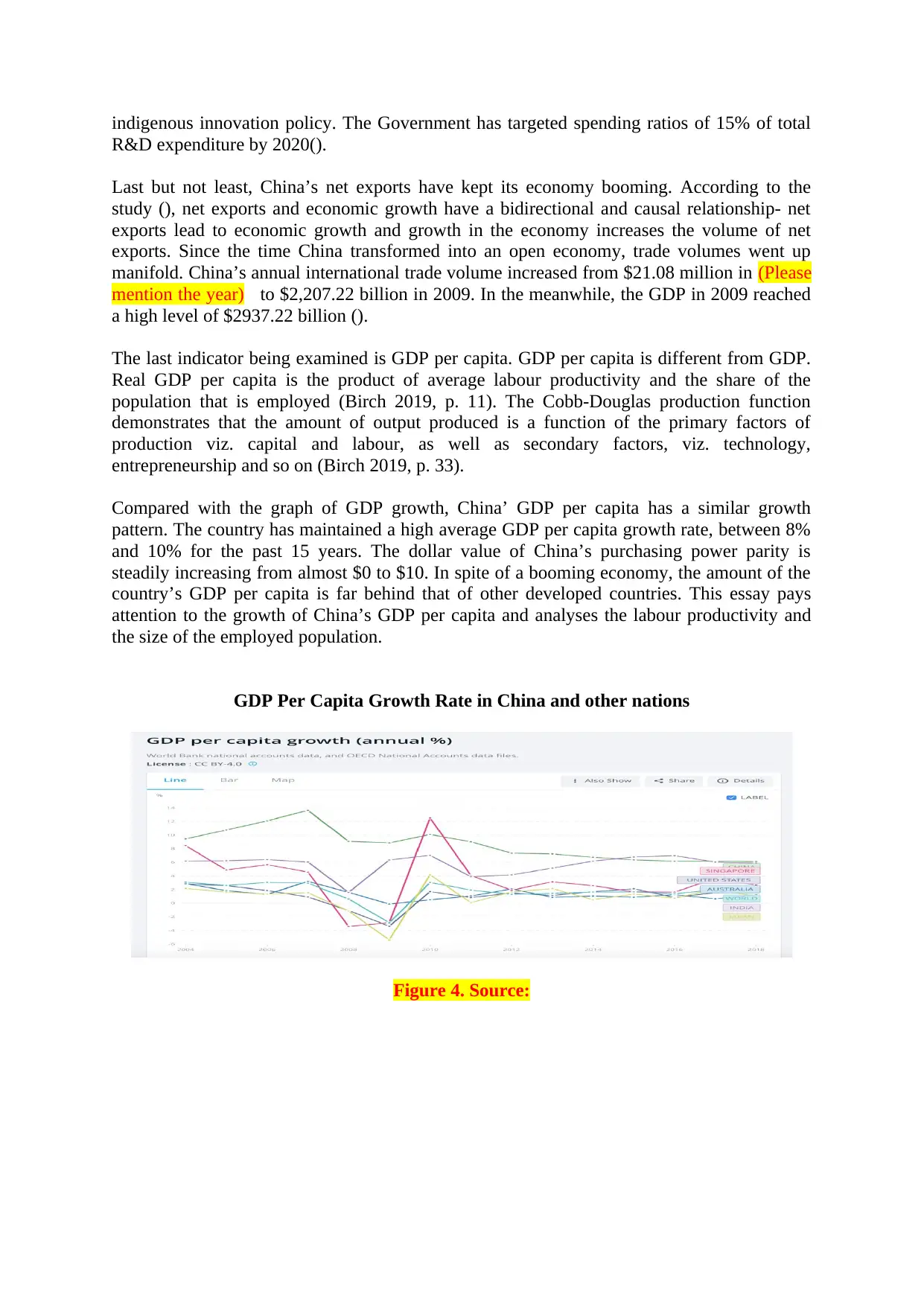
indigenous innovation policy. The Government has targeted spending ratios of 15% of total
R&D expenditure by 2020().
Last but not least, China’s net exports have kept its economy booming. According to the
study (), net exports and economic growth have a bidirectional and causal relationship- net
exports lead to economic growth and growth in the economy increases the volume of net
exports. Since the time China transformed into an open economy, trade volumes went up
manifold. China’s annual international trade volume increased from $21.08 million in (Please
mention the year) to $2,207.22 billion in 2009. In the meanwhile, the GDP in 2009 reached
a high level of $2937.22 billion ().
The last indicator being examined is GDP per capita. GDP per capita is different from GDP.
Real GDP per capita is the product of average labour productivity and the share of the
population that is employed (Birch 2019, p. 11). The Cobb-Douglas production function
demonstrates that the amount of output produced is a function of the primary factors of
production viz. capital and labour, as well as secondary factors, viz. technology,
entrepreneurship and so on (Birch 2019, p. 33).
Compared with the graph of GDP growth, China’ GDP per capita has a similar growth
pattern. The country has maintained a high average GDP per capita growth rate, between 8%
and 10% for the past 15 years. The dollar value of China’s purchasing power parity is
steadily increasing from almost $0 to $10. In spite of a booming economy, the amount of the
country’s GDP per capita is far behind that of other developed countries. This essay pays
attention to the growth of China’s GDP per capita and analyses the labour productivity and
the size of the employed population.
GDP Per Capita Growth Rate in China and other nations
Figure 4. Source:
R&D expenditure by 2020().
Last but not least, China’s net exports have kept its economy booming. According to the
study (), net exports and economic growth have a bidirectional and causal relationship- net
exports lead to economic growth and growth in the economy increases the volume of net
exports. Since the time China transformed into an open economy, trade volumes went up
manifold. China’s annual international trade volume increased from $21.08 million in (Please
mention the year) to $2,207.22 billion in 2009. In the meanwhile, the GDP in 2009 reached
a high level of $2937.22 billion ().
The last indicator being examined is GDP per capita. GDP per capita is different from GDP.
Real GDP per capita is the product of average labour productivity and the share of the
population that is employed (Birch 2019, p. 11). The Cobb-Douglas production function
demonstrates that the amount of output produced is a function of the primary factors of
production viz. capital and labour, as well as secondary factors, viz. technology,
entrepreneurship and so on (Birch 2019, p. 33).
Compared with the graph of GDP growth, China’ GDP per capita has a similar growth
pattern. The country has maintained a high average GDP per capita growth rate, between 8%
and 10% for the past 15 years. The dollar value of China’s purchasing power parity is
steadily increasing from almost $0 to $10. In spite of a booming economy, the amount of the
country’s GDP per capita is far behind that of other developed countries. This essay pays
attention to the growth of China’s GDP per capita and analyses the labour productivity and
the size of the employed population.
GDP Per Capita Growth Rate in China and other nations
Figure 4. Source:
Paraphrase This Document
Need a fresh take? Get an instant paraphrase of this document with our AI Paraphraser
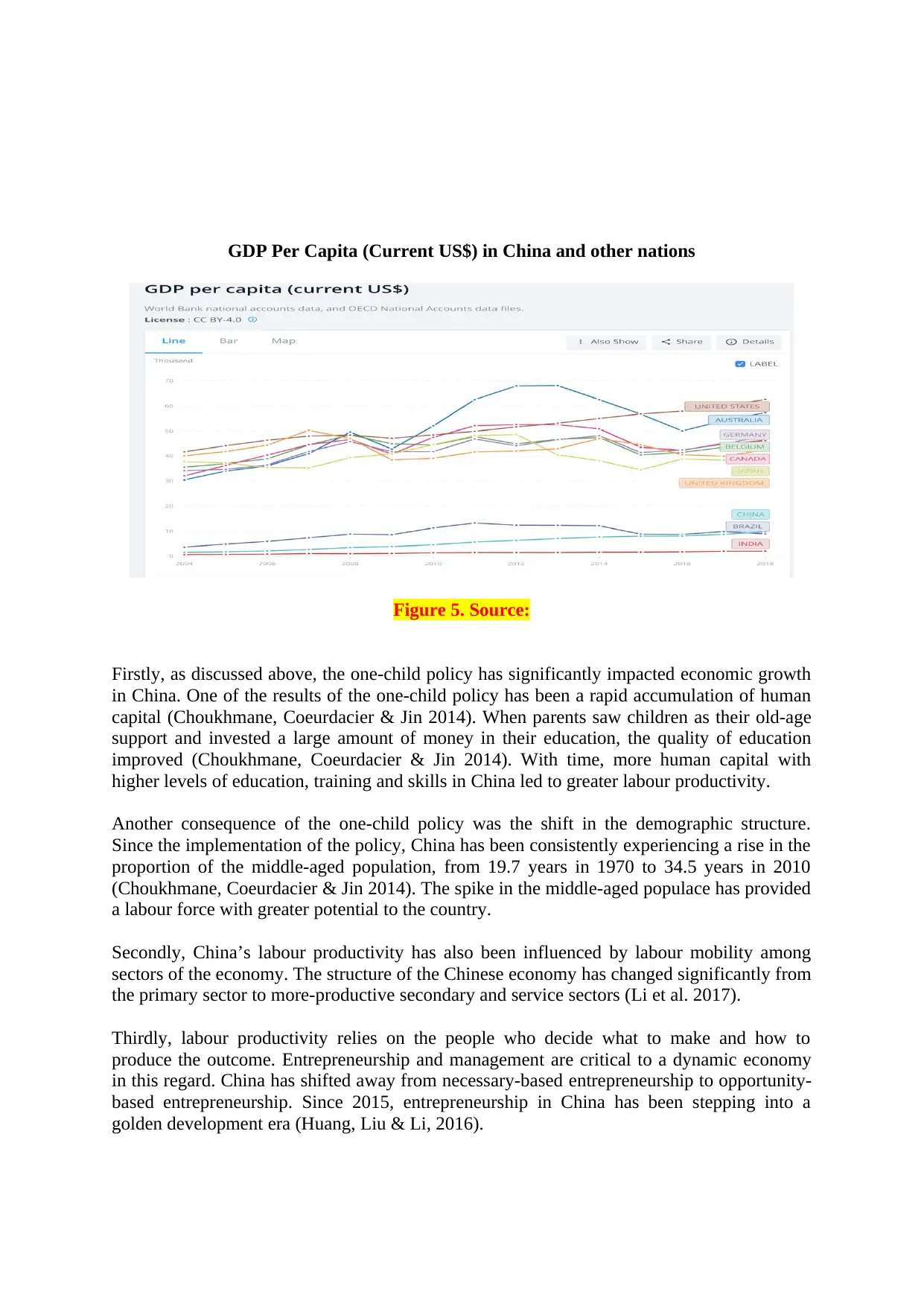
GDP Per Capita (Current US$) in China and other nations
Figure 5. Source:
Firstly, as discussed above, the one-child policy has significantly impacted economic growth
in China. One of the results of the one-child policy has been a rapid accumulation of human
capital (Choukhmane, Coeurdacier & Jin 2014). When parents saw children as their old-age
support and invested a large amount of money in their education, the quality of education
improved (Choukhmane, Coeurdacier & Jin 2014). With time, more human capital with
higher levels of education, training and skills in China led to greater labour productivity.
Another consequence of the one-child policy was the shift in the demographic structure.
Since the implementation of the policy, China has been consistently experiencing a rise in the
proportion of the middle-aged population, from 19.7 years in 1970 to 34.5 years in 2010
(Choukhmane, Coeurdacier & Jin 2014). The spike in the middle-aged populace has provided
a labour force with greater potential to the country.
Secondly, China’s labour productivity has also been influenced by labour mobility among
sectors of the economy. The structure of the Chinese economy has changed significantly from
the primary sector to more-productive secondary and service sectors (Li et al. 2017).
Thirdly, labour productivity relies on the people who decide what to make and how to
produce the outcome. Entrepreneurship and management are critical to a dynamic economy
in this regard. China has shifted away from necessary-based entrepreneurship to opportunity-
based entrepreneurship. Since 2015, entrepreneurship in China has been stepping into a
golden development era (Huang, Liu & Li, 2016).
Figure 5. Source:
Firstly, as discussed above, the one-child policy has significantly impacted economic growth
in China. One of the results of the one-child policy has been a rapid accumulation of human
capital (Choukhmane, Coeurdacier & Jin 2014). When parents saw children as their old-age
support and invested a large amount of money in their education, the quality of education
improved (Choukhmane, Coeurdacier & Jin 2014). With time, more human capital with
higher levels of education, training and skills in China led to greater labour productivity.
Another consequence of the one-child policy was the shift in the demographic structure.
Since the implementation of the policy, China has been consistently experiencing a rise in the
proportion of the middle-aged population, from 19.7 years in 1970 to 34.5 years in 2010
(Choukhmane, Coeurdacier & Jin 2014). The spike in the middle-aged populace has provided
a labour force with greater potential to the country.
Secondly, China’s labour productivity has also been influenced by labour mobility among
sectors of the economy. The structure of the Chinese economy has changed significantly from
the primary sector to more-productive secondary and service sectors (Li et al. 2017).
Thirdly, labour productivity relies on the people who decide what to make and how to
produce the outcome. Entrepreneurship and management are critical to a dynamic economy
in this regard. China has shifted away from necessary-based entrepreneurship to opportunity-
based entrepreneurship. Since 2015, entrepreneurship in China has been stepping into a
golden development era (Huang, Liu & Li, 2016).
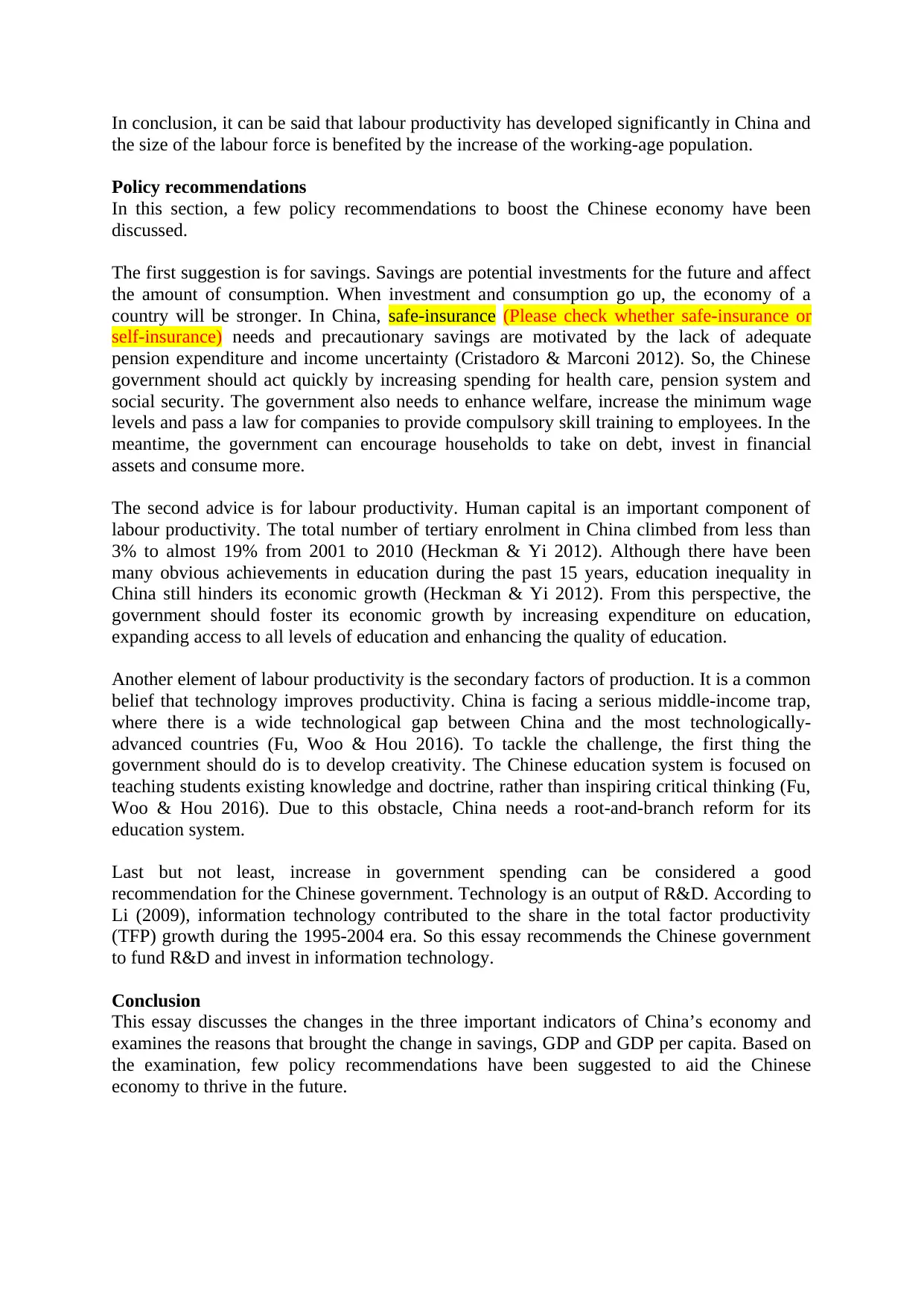
In conclusion, it can be said that labour productivity has developed significantly in China and
the size of the labour force is benefited by the increase of the working-age population.
Policy recommendations
In this section, a few policy recommendations to boost the Chinese economy have been
discussed.
The first suggestion is for savings. Savings are potential investments for the future and affect
the amount of consumption. When investment and consumption go up, the economy of a
country will be stronger. In China, safe-insurance (Please check whether safe-insurance or
self-insurance) needs and precautionary savings are motivated by the lack of adequate
pension expenditure and income uncertainty (Cristadoro & Marconi 2012). So, the Chinese
government should act quickly by increasing spending for health care, pension system and
social security. The government also needs to enhance welfare, increase the minimum wage
levels and pass a law for companies to provide compulsory skill training to employees. In the
meantime, the government can encourage households to take on debt, invest in financial
assets and consume more.
The second advice is for labour productivity. Human capital is an important component of
labour productivity. The total number of tertiary enrolment in China climbed from less than
3% to almost 19% from 2001 to 2010 (Heckman & Yi 2012). Although there have been
many obvious achievements in education during the past 15 years, education inequality in
China still hinders its economic growth (Heckman & Yi 2012). From this perspective, the
government should foster its economic growth by increasing expenditure on education,
expanding access to all levels of education and enhancing the quality of education.
Another element of labour productivity is the secondary factors of production. It is a common
belief that technology improves productivity. China is facing a serious middle-income trap,
where there is a wide technological gap between China and the most technologically-
advanced countries (Fu, Woo & Hou 2016). To tackle the challenge, the first thing the
government should do is to develop creativity. The Chinese education system is focused on
teaching students existing knowledge and doctrine, rather than inspiring critical thinking (Fu,
Woo & Hou 2016). Due to this obstacle, China needs a root-and-branch reform for its
education system.
Last but not least, increase in government spending can be considered a good
recommendation for the Chinese government. Technology is an output of R&D. According to
Li (2009), information technology contributed to the share in the total factor productivity
(TFP) growth during the 1995-2004 era. So this essay recommends the Chinese government
to fund R&D and invest in information technology.
Conclusion
This essay discusses the changes in the three important indicators of China’s economy and
examines the reasons that brought the change in savings, GDP and GDP per capita. Based on
the examination, few policy recommendations have been suggested to aid the Chinese
economy to thrive in the future.
the size of the labour force is benefited by the increase of the working-age population.
Policy recommendations
In this section, a few policy recommendations to boost the Chinese economy have been
discussed.
The first suggestion is for savings. Savings are potential investments for the future and affect
the amount of consumption. When investment and consumption go up, the economy of a
country will be stronger. In China, safe-insurance (Please check whether safe-insurance or
self-insurance) needs and precautionary savings are motivated by the lack of adequate
pension expenditure and income uncertainty (Cristadoro & Marconi 2012). So, the Chinese
government should act quickly by increasing spending for health care, pension system and
social security. The government also needs to enhance welfare, increase the minimum wage
levels and pass a law for companies to provide compulsory skill training to employees. In the
meantime, the government can encourage households to take on debt, invest in financial
assets and consume more.
The second advice is for labour productivity. Human capital is an important component of
labour productivity. The total number of tertiary enrolment in China climbed from less than
3% to almost 19% from 2001 to 2010 (Heckman & Yi 2012). Although there have been
many obvious achievements in education during the past 15 years, education inequality in
China still hinders its economic growth (Heckman & Yi 2012). From this perspective, the
government should foster its economic growth by increasing expenditure on education,
expanding access to all levels of education and enhancing the quality of education.
Another element of labour productivity is the secondary factors of production. It is a common
belief that technology improves productivity. China is facing a serious middle-income trap,
where there is a wide technological gap between China and the most technologically-
advanced countries (Fu, Woo & Hou 2016). To tackle the challenge, the first thing the
government should do is to develop creativity. The Chinese education system is focused on
teaching students existing knowledge and doctrine, rather than inspiring critical thinking (Fu,
Woo & Hou 2016). Due to this obstacle, China needs a root-and-branch reform for its
education system.
Last but not least, increase in government spending can be considered a good
recommendation for the Chinese government. Technology is an output of R&D. According to
Li (2009), information technology contributed to the share in the total factor productivity
(TFP) growth during the 1995-2004 era. So this essay recommends the Chinese government
to fund R&D and invest in information technology.
Conclusion
This essay discusses the changes in the three important indicators of China’s economy and
examines the reasons that brought the change in savings, GDP and GDP per capita. Based on
the examination, few policy recommendations have been suggested to aid the Chinese
economy to thrive in the future.
⊘ This is a preview!⊘
Do you want full access?
Subscribe today to unlock all pages.

Trusted by 1+ million students worldwide

References
1 out of 7
Related Documents
Your All-in-One AI-Powered Toolkit for Academic Success.
+13062052269
info@desklib.com
Available 24*7 on WhatsApp / Email
![[object Object]](/_next/static/media/star-bottom.7253800d.svg)
Unlock your academic potential
Copyright © 2020–2025 A2Z Services. All Rights Reserved. Developed and managed by ZUCOL.





